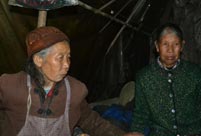

MILAN, Italy, April 30 -- China's first self-built pavilion at an overseas exposition shows China's openness as a vast nation able to foster global development through modernity rooted deep in the past, project leader Su Dan said in a recent interview.
World expositions are the place where different countries have the chance to showcase their culture and tradition, Su, Deputy Dean of Academy of Arts and Design at Tsinghua University, noted.
"But this time the focus of China pavilion was not put on the use of Chinese typical architecture... today China is a fast-developing power and has to find new ways to fully express its spirit and ideas," he told Xinhua.
Su explained that the China pavilion, designed by a team from the Academy of Arts and Design at Tsinghua University, is built on the idea of harmony between humanity and nature.
Sky, Land and Man are the three components of the balance between nature and human research for sustainable development pursued by China, in line with the Expo Milano 2015's leading theme "Feeding the Planet, Energy for Life" dedicated to healthy and sustainable nutrition for humankind, Su said.
Inside the China pavilion, the second largest self-built pavilion after Germany's at the Milan Expo, visitors will see a demonstration of the diversity of China's lands and foods influenced by the thinking of man being an integral part of nature.
Thus the pavilion's journey through the traditions of Chinese agriculture and the progress of science and technology will lead visitors into China's past and future, Su elaborated.
The fact that China for the first time undertook the challenge to self-build its national pavilion at an overseas world exposition is also very important to understand the Asian country's new course at the global level, Su pointed out.
"Renting a pavilion would have been a sign of China's narrowness, while self-building one was a sign of China's openness," he said. In fact building a national pavilion abroad, he went on saying, means having to cope with different cultural environment, legislation and language.
Nevertheless, China was able to successfully carry out this "pioneering work" even investing much less that the European pavilions did and in line with the Asian country's pro-frugality policies as well as the Expo's call on commitment to respect the Earth's resources.
The China pavilion will debut along with the expositions of more than 140 countries and organizations on Friday, when the Expo Milano 2015 will officially kick off in the Italian northern city.
Yet the task of Tsinghua University will not end when the Italian event will close on Oct. 31, Su said. The World Expo Design Research Center of Tsinghua University, established last year, will continue to foster China's new global course in future expositions.
 J-11 fighters in air exercise
J-11 fighters in air exercise Beauties dancing on the rings
Beauties dancing on the rings Attendants-to-be join Mr. & Miss Campus Contest
Attendants-to-be join Mr. & Miss Campus Contest Beijing's toughest anti-smoking law takes effect
Beijing's toughest anti-smoking law takes effect Family lives in cave for about 50 years in SW China
Family lives in cave for about 50 years in SW China PLA soldiers operating vehicle-mounted guns in drill
PLA soldiers operating vehicle-mounted guns in drill Blind carpenter in E China's Jiangxi
Blind carpenter in E China's Jiangxi China hosts overseas disaster relief exercise for the first time
China hosts overseas disaster relief exercise for the first time 20 pairs of twins who will become flight attendants in Sichuan
20 pairs of twins who will become flight attendants in Sichuan Obama is sowing discontent in S.China Sea
Obama is sowing discontent in S.China Sea Rescuers work through night to reach cruise ship survivors
Rescuers work through night to reach cruise ship survivors Driving through limbo
Driving through limbo Facing down MERS
Facing down MERSDay|Week